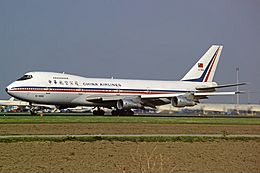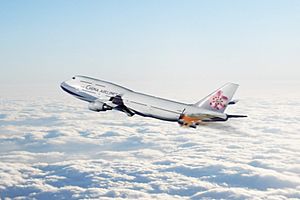China Airlines Flight 611 facts for kids

A similar Boeing 747-200B of China Airlines at Amsterdam Schiphol Airport
|
|
| Accident summary | |
|---|---|
| Date | May 25, 2002 |
| Summary | Metal fatigue causing in-flight breakup and explosive decompression |
| Place | 45 km Northeast of Penghu Islands, Taiwan |
| Passengers | 206 |
| Crew | 19 |
| Injuries (non-fatal) | 0 |
| Fatalities | 225 |
| Survivors | 0 |
| Aircraft type | Boeing 747-209B |
| Airline/user | China Airlines |
| Registration | B-18255 (Previously B-1866) |
| Flew from | Taipei-Chiang Kai-Shek International Airport |
| Flying to | Hong Kong-Chek Lap Kok International Airport |
China Airlines Flight 611 was a regular passenger flight that flew from Taipei, Taiwan to Hong Kong, China. On May 25, 2002, the Boeing 747-209B airplane broke into pieces while flying over the Taiwan Strait and crashed into the water. This happened about 25 minutes after the plane took off.
The accident was caused by something called metal fatigue in the back part of the plane. Metal fatigue is when a metal gets weak and cracks over time from repeated stress. This problem was linked back to a repair that was not done correctly 22 years before the accident. Sadly, all 225 people on board the plane lost their lives.
Contents
The Plane's Story
The Boeing 747-209B plane that was Flight 611 was known by its registration number B-18255. China Airlines received this plane on July 31, 1979. It had four powerful Pratt & Whitney JT9D engines. By the time of the accident, the plane had flown for over 64,000 hours. It had also taken off and landed more than 21,000 times.
The Tail Strike Incident
On February 7, 1980, the tail of this very same plane hit the runway while landing at Hong Kong airport. A quick, temporary repair was done the next day. A more permanent repair was done later, from May 23 to 26, 1980.
However, investigators later found out that this repair was not done correctly. It did not meet the high standards set by Boeing for repairs. They also found that 29 checks for corrosion (rusting) were not completed on this part of the plane after 1997.
When parts of the plane from the crash site were found, especially the repaired area, there was proof that deep scratches had been smoothed out. This made the metal thinner than it should have been. Several cracks from metal fatigue were found in these thin areas. Experts believe a crack about 2.3 metres (7.5 feet) long might have caused the plane to break apart.
Who Was Flying the Plane?
The people flying the plane were:
- Captain Yi Ching-Fung, 51 years old. He joined China Airlines in 1991 and became a captain in 1997. He had flown for over 10,000 hours.
- First Officer Hsieh Ya Shiung, 52 years old. He joined China Airlines in 1990 and had flown for over 10,000 hours.
- Flight Engineer Sen Kuo Chao. He joined China Airlines in 1977 and had flown for over 19,000 hours.
Since the Boeing 747-200B was an older type of plane, it needed a flight engineer to help manage the aircraft systems. All three pilots had rested for more than 24 hours before this flight.
People on Board
There were 206 passengers and 19 crew members on Flight 611.
- Most of the passengers (190) were from Taiwan.
- Nine passengers were from mainland China.
- Five passengers were from Hong Kong.
- One passenger was from Singapore.
- One passenger was from Switzerland.
- All 19 crew members were from Taiwan.
The Accident
On May 25, 2002, the plane, B-18255, was actually going to be sold to another airline, Orient Thai Airlines. This flight was supposed to be its last day of service with China Airlines.
The plane took off at 3:07 PM. It was cleared to climb to 20,000 feet. At 3:16 PM, it was cleared to climb higher, to 35,000 feet. Around 3:30 PM, as the plane was almost at 35,000 feet, it suddenly disappeared from the radar screens used by air traffic control. All communication with the plane was lost. No distress signals were sent out by the pilots. However, two Cathay Pacific planes flying nearby did pick up emergency signals from Flight 611.
Later, investigators found that Flight 611 had broken apart in the air as it was reaching 35,000 feet. All 225 people on board were lost. This was one of the worst disasters in aviation history involving a plane breaking up in mid-air.
How the Crash Was Investigated
The Aviation Safety Council (ASC) of Taiwan investigated the crash. During their investigation, they noticed that the crash of China Airlines Flight 611 was similar to another crash, TWA Flight 800. Both crashes involved:
- Boeing 747 planes.
- Planes taking off in very hot weather.
- Planes breaking apart without warning.
- Planes breaking apart while reaching or at their cruising altitude (their highest flying height).
However, unlike TWA Flight 800, investigators found that Flight 611 was not caused by a fuel tank explosion.
Finding Clues
Both the flight recorders (the "black boxes") were found. However, they didn't immediately show the cause. The flight data recorder showed that the plane was working normally before it broke up. The cockpit voice recorder also didn't show anything unusual. It recorded the captain saying "two thousand" at 3:26 PM, and then nothing more was spoken. The sound of the plane breaking up was heard around 3:29 PM.
With no clear answers from the recorders, investigators used a method similar to the TWA Flight 800 investigation. They used several pieces of the wreckage to figure out which part of the plane fell off first. This was a big clue: the wreckage from the back of the plane fell first. So, investigators focused on finding pieces from the plane's tail section.
Eventually, they found a specific piece of wreckage, item number 640, which had been damaged in the 1980 tail strike incident. A metal plate, called a doubler, had been placed over the scratches from that incident. This piece was sent to Taipei for a closer look.
What Caused the Crash?
When investigators removed the doubler plate from Item 640, they found that the scratches from the tail strike 22 years ago were still there. This was not the correct way to fix the damage. From this, investigators learned what really happened during the repair in 1980.
The Incorrect Repair
According to Boeing's repair manual, deep scratches should be sanded down. If the scratches are too deep, the damaged section should be cut out. Then, a doubler plate, 30% larger than the cut-out section, should be put in its place.
However, the workers who repaired the plane in 1980 did not follow these instructions. Instead, they just placed a doubler plate over the damaged section. This plate was not 30% larger than what should have been cut out. This made the plane's structure weaker behind the doubler. The workers then made another mistake: they wrote in the repair log book that the repair was done correctly. So, anyone reading the log book would think the repair was done properly.
Cracks Growing Over Time
Over the years, the cracks under the doubler plate got worse and worse. Every time the plane took off and landed, the cracks grew longer. Eventually, they reached 2.3 metres (7.5 feet) in length.
Then, on May 25, 2002, the cracks reached a breaking point. They grew very quickly in all directions, causing the entire tail section to break away from the plane. The plane then went into a steep dive and was torn apart in the air.
China Airlines Maintenance Checks
Another reason why this mistake was not found earlier relates to the maintenance checks at China Airlines. In 1988, the roof of Aloha Airlines Flight 243 peeled off during a flight, also causing a sudden loss of air pressure. After that accident, the FAA (a government agency that oversees air travel) told airlines to check all previous repairs on their planes again.
China Airlines started checking their repairs in 2001. Workers took photos of 31 different doubler plates on various 747s, including the one on B-18255. Even though there was a stain on the doubler of B-18255, the workers chose to ignore it. This stain was actually caused by smoke. Passengers were allowed to smoke on planes until 1995. The smoke was forced out through the hidden crack, and nicotine stained the plane's outer skin. It has been said that if China Airlines had investigated how that stain formed, they might have found the cracks and stopped the crash from happening.
The next major maintenance check for this plane was scheduled for November 2, 2002. This check would likely have led workers to find the cracks. However, the plane crashed five months before that check was due.
After the Crash
After the accident, China Airlines no longer uses 611 as a flight number.
Similar Accidents
- Japan Airlines Flight 123 - This crash was also caused by an incorrect repair after a tailstrike, which eventually led to the plane losing control.
- Aloha Airlines Flight 243 - This accident was also caused by metal fatigue.
Images for kids
See also
 In Spanish: Vuelo 611 de China Airlines para niños
In Spanish: Vuelo 611 de China Airlines para niños


